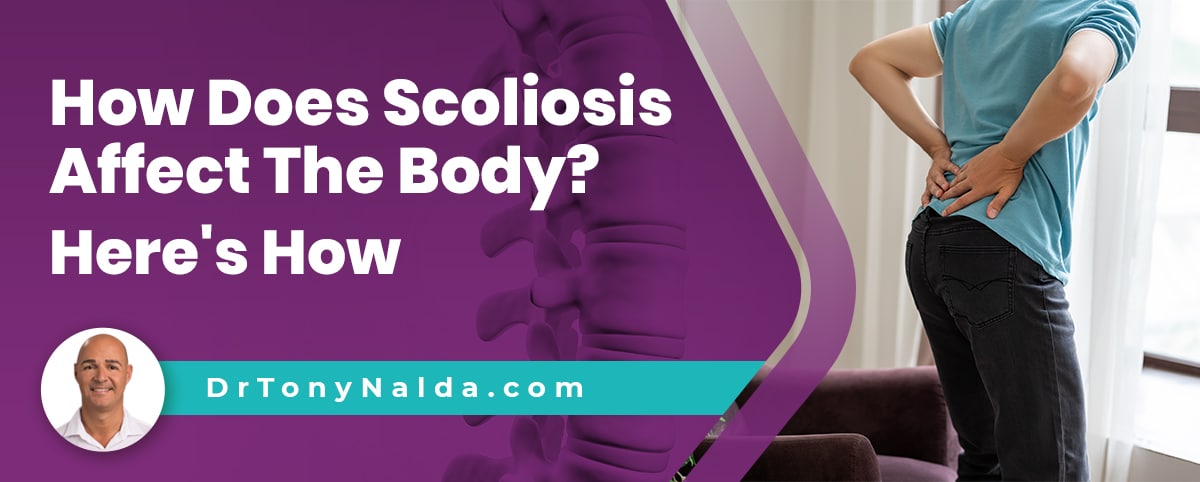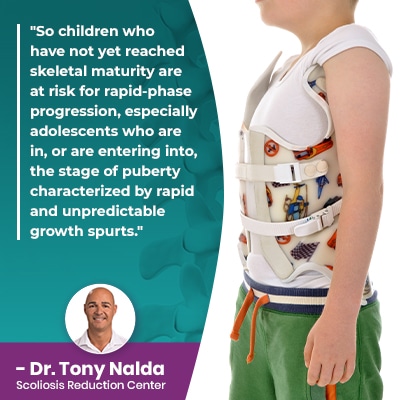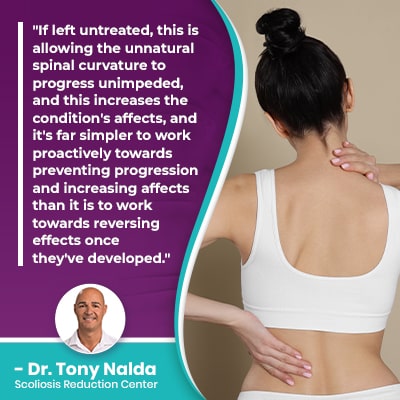How Does Scoliosis Affect The Body? Here's How

Scoliosis affects the body in a number of ways, and as no two cases of scoliosis are the same, treatment plans have to be fully customized to address key patient/condition variables. Scoliosis will affect the body differently based on patient age, how severe the condition is, the type of scoliosis, and where the scoliosis develops in the spine.
Although scoliosis is a spinal condition, it can affect the body in multiple ways, and scoliosis is also known to affect adults and children differently. The main symptoms of scoliosis in adults is pain, while the main symptoms of scoliosis in children involve postural changes.
Before getting to the specific effects of scoliosis, let's explore how scoliosis is diagnosed.
Table of Contents
Diagnosing Scoliosis
The spine allows us to stand upright, practice good posture, move flexibly, and the spinal cord within works with the brain to form the body's central nervous system (CNS), which is why spinal conditions can affect the entire body in different ways.
Here at the Scoliosis Reduction Center, I diagnose scoliosis through a comprehensive physical examination that includes taking the patient's family history, observing how the patient walks, their posture, and performing an Adam's forward bend test.
An Adam's forward bend test is known as the gold standard of scoliosis screening and involves patients standing in front of me, hinging forward at the hips to bend at a 90-degree angle with the arms hanging down at the sides; in this position, the spine is highly visible, as are any postural asymmetries that indicate the condition's presence.
If an Adam's test reveals some condition indicators, further screening/testing is warranted, and this will involve a scoliosis X-ray to determine what's really happening in and around the spine.
Scoliosis is the development of an unnatural sideways spinal curve that also rotates, making it a 3-dimensional condition.
In addition, the size of a scoliotic curve has to be a minimum of 10 degrees to be considered a true scoliosis, and this is determined through a measurement known as Cobb angle.
Cobb angle is measured during X-ray by drawing lines from the tops and bottoms of the curve's most-tilted vertebrae, at its apex; the resulting angle is expressed in degrees and tells me how far out of alignment the spine is, and classifies conditions based on severity:
- Mild scoliosis: Cobb angle measurement of between 10 and 25 degrees
- Moderate scoliosis: Cobb angle measurement of between 25 and 40 degrees
- Severe scoliosis: Cobb angle measurement of 40+ degrees
- Very-severe scoliosis: Cobb angle measurement of 80+ degrees
The more severe the condition, the more noticeable its effects are going to be, so let's move on to addressing the main condition affects in childhood scoliosis versus how it affects older adults.
How Does Scoliosis Affect Children?
Scoliosis can affect all ages from babies to the elderly and every age in between.
When it comes to scoliosis in young patients, we're talking about congenital scoliosis diagnosed in babies born with the condition, infantile scoliosis diagnosed between 6 months old and 3 years of age, early-onset juvenile scoliosis diagnosed between the ages of 3 and 10, and adolescent idiopathic scoliosis, diagnosed between the ages of 10 and 18.
Adolescent idiopathic scoliosis (AIS) is the condition's most-prevalent form overall, so for our current purposes, we'll focus on how scoliosis affects adolescents.
An important condition characteristic to understand is its progressive nature, meaning it's virtually guaranteed to get worse over time, and in the most common type to affect both adults and children, idiopathic scoliosis, we don't know what triggers its initial onset, but we do understand what triggers it to progress: growth and development.
 So children who have not yet reached skeletal maturity are at risk for rapid-phase progression, especially adolescents who are in, or are entering into, the stage of puberty characterized by rapid and unpredictable growth spurts.
So children who have not yet reached skeletal maturity are at risk for rapid-phase progression, especially adolescents who are in, or are entering into, the stage of puberty characterized by rapid and unpredictable growth spurts.
As a condition progresses, the size of the unnatural spinal curve is increasing, as are the condition's uneven forces, and its effects.
The main ways in which scoliosis affects children involve different levels of postural deviation:
- Uneven shoulders
- Uneven shoulder blades
- The development of a rib arch (most common in thoracic scoliosis)
- An uneven waistline
- Uneven hips
- Arms and legs that appear to hang at different lengths
In addition to these types of postural changes, additional effects can include changes to gait, balance, coordination, and clothing that suddenly seems ill-fitting.
As scoliosis progresses, the spine gets increasingly rigid, making it less responsive to treatment, and can also make it difficult for patients to perform key therapeutic exercises as part of treatment; this is why being proactive with treatment can be so beneficial.
So now that we've talked about the condition's most-noticeable effects in children, let's move on to adult scoliosis.
How Does Scoliosis Affect Adults?
While scoliosis is most commonly diagnosed in children, it does affect adults.
The two most common types of scoliosis to affect adults are idiopathic scoliosis and degenerative scoliosis.
Cases of idiopathic scoliosis are extensions of adolescent idiopathic scoliosis cases that were undiagnosed and untreated during adolescence, so they progress with time and maturity into adulthood, when the condition becomes compressive and painful.
You'll likely notice I didn't mention pain when addressing scoliosis in children, and that is because scoliosis doesn't become compressive until skeletal maturity has been reached, and it's compression of the spine and its surrounding muscles and nerves that causes the majority of condition-related pain.
While children can most certainly experience related muscle pain, back and nerve pain is more commonly associated with the adult experience of scoliosis.
A growing spine is experiencing a constant lengthening motion that counteracts the compressive force of the unnatural spinal curve, while adults are vulnerable to compression, and pain is the number-one symptom that brings adults in to see me for a diagnosis and treatment.
Back pain is common, but it's more often pain that radiates into the body's extremities that triggers an adult's awareness that something is wrong.
After idiopathic scoliosis, the most common type to affect adults is degenerative scoliosis, caused by natural age-related spinal degeneration, and as the spine deteriorates over time, its ability to maintain its natural curves and alignment is disrupted.
So scoliosis patients who have reached skeletal maturity are the most vulnerable to compression and can cause varying levels of back pain ranging from mild and intermittent to chronic back pain that's debilitating.
While adults with scoliosis will also experience postural changes, particularly a prominent lean to one side, pain is the most noticeable effect.
What Happens if Scoliosis is Left Untreated?
When talking about how scoliosis affects the body, I want to address what happens if the condition is left untreated, and this is important because as a progressive condition, its effects are going to increase over time, and the best way to minimize those affects, for all ages, is proactive treatment.
When it comes to scoliosis treatment options, we're talking about how best to respond to a diagnosis of scoliosis, and in my experience, when to respond is of the utmost importance.
As a progressive condition, it's going to get worse over time, so why not start treating scoliosis as close to the time of diagnosis as possible; remember, scoliosis is simplest to treat early in its progressive line before spinal rigidity has increased and before the body has had ample time to adjust to the spine's abnormal sideways curvature.
Different types of scoliosis have different treatment needs.
Idiopathic scoliosis, for example, is a typical form and accounts for approximately 80 percent of known diagnosed cases, and the remaining 20 percent are associated with known causes: neuromuscular scoliosis, degenerative scoliosis, and congenital scoliosis.
Neuromuscular scoliosis is caused by the presence of a larger underlying neuromuscular condition such as cerebral palsy, spina bifida, and muscular dystrophy, so the treatment process is more complex because the larger neuromuscular condition has to be the focus of treatment.
 If left untreated, this is allowing the unnatural spinal curvature to progress unimpeded, and this increases the condition's affects, and it's far simpler to work proactively towards preventing progression and increasing affects than it is to work towards reversing effects once they've developed.
If left untreated, this is allowing the unnatural spinal curvature to progress unimpeded, and this increases the condition's affects, and it's far simpler to work proactively towards preventing progression and increasing affects than it is to work towards reversing effects once they've developed.
In particularly severe cases, and/or if left untreated, complications can develop that affect the digestive system (irritable bowel syndrome), issues with bowel control, fine motor control, acid reflux, migraines, and lung impairment.
So the take-away here is that regardless of patient age and severity, the best time to start scoliosis treatment is always now.
Conclusion
Scoliosis symptoms will vary from one person to the next, so what one patient experiences isn't always indicative of what others will face.
When an unnatural curvature of the spine develops, it's not just the spine and its surrounding muscles and nerves that are exposed to uneven forces, but also the entire body.
One of the goals of treatment, here at the Center, is to help patients avoid the need for invasive surgical intervention; while spinal fusion surgery has a place in scoliosis treatment, it is a costly, invasive, and risky procedure that can cost the spine in terms of its overall health, strength, and function.
The best way to minimize the effects of scoliosis is to treat it proactively, and the success of conservative chiropractic-centered treatment proves that not all cases of scoliosis require surgery.
Dr. Tony Nalda
DOCTOR OF CHIROPRACTIC
After receiving an undergraduate degree in psychology and his Doctorate of Chiropractic from Life University, Dr. Nalda settled in Celebration, Florida and proceeded to build one of Central Florida’s most successful chiropractic clinics.
His experience with patients suffering from scoliosis, and the confusion and frustration they faced, led him to seek a specialty in scoliosis care. In 2006 he completed his Intensive Care Certification from CLEAR Institute, a leading scoliosis educational and certification center.
About Dr. Tony Nalda
 Ready to explore scoliosis treatment? Contact Us Now
Ready to explore scoliosis treatment? Contact Us Now





